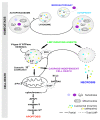Lysosomes as a Target of Anticancer Therapy
- PMID: 36768500
- PMCID: PMC9916765
- DOI: 10.3390/ijms24032176
Lysosomes as a Target of Anticancer Therapy
Abstract
Lysosomes are organelles containing acidic hydrolases that are responsible for lysosomal degradation and the maintenance of cellular homeostasis. They play an important role in autophagy, as well as in various cell death pathways, such as lysosomal and apoptotic death. Various agents, including drugs, can induce lysosomal membrane permeability, resulting in the translocation of acidic hydrolases into the cytoplasm, which promotes lysosomal-mediated death. This type of death may be of great importance in anti-cancer therapy, as both cancer cells with disturbed pathways leading to apoptosis and drug-resistant cells can undergo it. Important compounds that damage the lysosomal membrane include lysosomotropic compounds, antihistamines, immunosuppressants, DNA-damaging drugs, chemotherapeutics, photosensitizers and various plant compounds. An interesting approach in the treatment of cancer and the search for ways to overcome the chemoresistance of cancer cells may also be combining lysosomotropic compounds with targeted modulators of autophagy to induce cell death. These compounds may be an alternative in oncological treatment, and lysosomes may become a promising therapeutic target for many diseases, including cancer. Understanding the functional relationships between autophagy and apoptosis and the possibilities of their regulation, both in relation to normal and cancer cells, can be used to develop new and more effective anticancer therapies.
Keywords: apoptosis; autophagy; cathepsins; lysosomal membrane permeability; lysosomes.
Conflict of interest statement
The authors declare no conflict of interest.
Figures
References
Publication types
MeSH terms
Substances
Grants and funding
LinkOut - more resources
Full Text Sources
Medical



